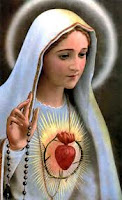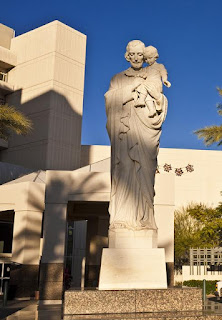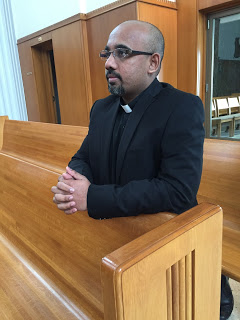seems that Moslems and Christians have no common ground. Yet, there is one who
can bring us together–Mary, our Blessed Mother. Mary is greatly loved by both
Muslims and Catholics.
The Virgin
Mary plays a very significant role in Islam. They do not believe as we do, that
Mary is the Mother of God through her motherhood of Jesus, but they share many
Catholic teachings. Mary’s name appears
more times in the Koran than in the New Testament. Of the Koran’s 114 chapters,
Mary is among the eight people who have a chapter named after them. The
nineteenth chapter is named “Mariam” which means Mary in Arabic.
considered ever-virgin and the only woman mentioned by name in the Koran.
Muslims believe that she is without sin. The Hadith—book of Islamic
tradition—teaches that there are only two that Satan never touched at
birth–Jesus and Mary. The Koran contains verses on the Annunciation,
Visitation, and Nativity. Fatima, the daughter of Mohammed, was also revered by
him. But after her death Mohammed wrote: “Thou shalt be the most blessed
of all women in Paradise, after Mary.”
Christian religions either totally ignore or minimize Mary’s role in salvation,
Catholics and Moslems share a great love and reverence for the mother of our
Lord, Jesus Christ. The fact that Mary
appeared at Fatima, Portugal, a Catholic town bearing this revered Muslim name,
(named for a Muslim princess) is a great sign for our times.
Portugal draws millions of Moslem and Catholic pilgrims every year. It is the Blessed Mother who calls them and
it is her message that can do the seemingly impossible; heal this world and
bring peace. Ultimately, it is God’s plan for as always, Mary wishes for us
to, “Do whatever he tells you.” (John
2:5)
Fatima is in central Portugal. The Apostle James evangelized Portugal in the
early centuries. Historical records show
that at least since 656 A.D., the nation of Portugal has had a devotion to Mary
under the title of the Immaculate Conception. Portugal was invaded by the Moors
(Moslems) in 711. Under King Alfonso
Henriques (1128-1185) Portugal gained her independence. As King, he placed
Portugal under the protection of Mary, naming her “Protectress and Mother of
all the Portuguese.” Afterwards, Mary’s queenship was proclaimed by a
succession of kings.
long history of devotion to the Blessed Mother reveals it as an especially
appropriate place for her visitations.
Here is a review of the events, keeping in mind that the Catholic Church
is very slow and conservative about approving any claim of apparitions. No one
is required to believe in an apparition as a requirement of the Catholic faith.
However, it’s reasonable to judge apparitions worthy of belief after Church
authority has investigated and accepted them. Miracles and conversions often
result through these apparitions and many sites have been visited by hundreds
of thousands of pilgrims such as Fatima, Portugal
1917, three young children were tending a flock of sheep in a field in the
outskirts of Fatima. The children were Lucia of Jesus, 10, Francisco Marto, 9,
and his sister Jacinta, 7. (Francisco and Jacinta were beatified May 13, 2000
and the case for beatification has opened for Sr. Lucia who died in 2005 at the
age of 97.)
Around
midday, they prayed the Rosary, as was their habit after lunch. A flash of
light in the sky made them think lightening was warning of an impending
storm. Instead, there was another flash
and then a beautiful Lady appeared, brighter than the sun and holding a rosary.
She explained to the children: “I am the Lady of the Rosary” and told them to
pray, do penance, and to make sacrifices to save sinners. She invited the children to return to the Cove
of Iria during the next five consecutive months on the thirteenth at the
very same hour.
Fatima in the ensuing months. In the last apparition on October 13, Our Lady
had promised a miracle so that all would believe. A crowd estimated at 70,000—including
many newspaper reporters and skeptics–came from all over in the pouring rain
to the Cova da Iria. What took place became known as “Miracle of
the Sun“. It had rained all day until
the appointed time. Then, the steady rain suddenly ceased. The sun swirled in
the sky and great shafts of color flooded the entire plateau of Fatima.
realize that their soaked clothing and everything around them had completely
dried in spite of being soaked just moments earlier. Many secular newspapers
testified to these events with eyewitness reports and photographs of the great
crowd.
Our Lady appeared to the three shepherd children, she asked them to pray the
rosary and do penance for our sins and sins throughout the world. It is a plan
to reunite us in friendship with Christ and bring peace to the world.
also told Lucia that she promised to assist at the hour of death with all the
graces necessary for salvation all those who, on the first Saturday of five
consecutive months, go to Confession and receive Holy Communion, recite five
decades of the Rosary and keep her company for a quarter of an hour while
mediating on the mysteries of the Rosary with the intention of making
reparation for sins in the world.
from the assassin’s bullet on May 13, 1981.
Before a crowd of 20,000 in St. Peter’s Square at the Vatican, a Turkish
citizen, Mehmet Ali Agca, fired four bullets at the pope from about 15 feet
away.
reflected: “Agca knew how to shoot, and he certainly shot to kill. Yet it
was as if someone was guiding and deflecting that bullet.” That someone,
John Paul believed, was the Lady of Fatima. “Could I forget that the event
in St. Peter’s Square took place on the day and at the hour when (of) the first
appearance of the Mother of Christ at Fatima in Portugal? For in everything that happened to me on that
very day, I felt that extraordinary motherly protection and care, which turned
out to be stronger than the deadly bullet” (Memory and Identity pp. 159,
163).
John Paul II’s second visit to Fatima, he entrusted the “new evangelization” to
her maternal care, giving her the title of “Our Lady of the New
Evangelization.”
Connection
Catholic devotion yet, there is an uncanny connection to Islam.
of Fatima was given the Islamic name of the well-loved Moslem Princess from the
nearby Castle of Ourem who stayed behind and converted to Catholicism. She was
named Fatima, like many other Moslem girls in honor of Mohammad’s daughter. She
was baptized in 1158 with the Christian name of Ouereana but died at an early age after marrying the Count of
Ourem.
Christians and Moslems. In his 1952 book, The
World’s First Love, Archbishop (then Bishop) Sheen included a chapter on
“Our Lady and the Moslems.” He wrote:
happen not through the direct teachings of Christianity, but through a
summoning of the Moslems to a veneration of the Mother of God.
Significance of Our Blessed Mother Mary, then, is for the Moslems the true
Sayyida, or Lady. The only possible serious rival to her in their creed would
be Fatima, the daughter of Mohammed himself. But after the death of Fatima,
Mohammed wrote: Thou shalt be the most blessed of all the women in Paradise,
after Mary. In a variant of the text, Fatima is made to say, “I surpass all the
women, except Mary.” “This brings us to our second point: namely, why the
Blessed Mother, in the 20th century, should have revealed herself in the
significant little village of Fatima, so that to all future generations she
would be known as Our Lady of Fatima. Since nothing ever happens out of Heaven
except with a finesse of all details, I believe that the Blessed Virgin chose
to be known as Our Lady of Fatima as a pledge and a sign of hope to the Moslem
people, and as an assurance that they, who show her so much respect, will one
day accept her divine Son too.
support these views is found in the historical fact that the Moslems occupied
Portugal for centuries. At the time when they were finally driven out, the last
Moslem chief had a beautiful daughter by the name of Fatima. A Catholic boy
fell in love with her, and for him she not only stayed behind when the Moslems
left, but even embraced the Faith. The
young husband was so much in love with her that he changed the name of the town
where he lived to Fatima. Thus, the very place where our Lady appeared in 1917
bears a historical connection to Fatima, the daughter of Mohammed. “Mary is
the advent of Christ, bringing Christ to the people before Christ Himself is
born. In an apologetic endeavor, it is always best to start with that which
people already accept. Because the Moslems have a devotion to Mary, our
missionaries should be satisfied merely to expand and to develop that devotion,
with the full realization that Our Blessed Lady will carry the Moslems the rest
of the way to her divine Son. She is forever a traitor, in the sense that she
will not accept any devotion for herself, but will always bring anyone who is
devoted to her to her divine Son.”
“Peace Congress” in Lisbon, Portugal in 1951, Archbishop Sheen made this
observation: “Our Lady has been chosen to be known by the name of Fatima, which
was the name of the daughter of Mohammed, because She has come not only for the
conversion of Russia but also for the millions of Mohammedans…without whom
there could never be true world peace.”
of Our Lady of Fatima continue to be relevant today. In view of the increasing terrorism inflicted
in the modern world, Our Lady of Fatima is a powerful intercessor. She is the
bridge that can bring us together.
& Pacwa, Fr. Mitch, Islam & Christianity, Volumes I-V, Ignatius
Productions 2003
Cardinal Tarcisio, The Last Secret of Fatima, Doubleday 2008
Tan Books and Publishers, Inc. 1980
(then Bishop) Sheen, The World’s First Love, (orig 1952) Ignatius
Press,2009
——————————————————————————–










Patti I was at a Fatima conference on Long Island and a Muslim man came to me asking questions about Our Lady of Fatima whom he called St Fatima. He had her statue in his home and had a devotion to her. By the end of the conference, he was being prayed over by the priest and converted! Our Lady brought her son Mohammed to her Son Jesus!
Wow, what an amazing story! Thanks for sharing, Leticia.